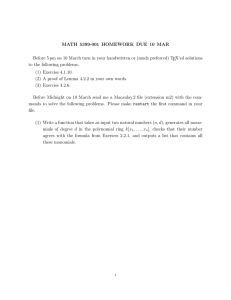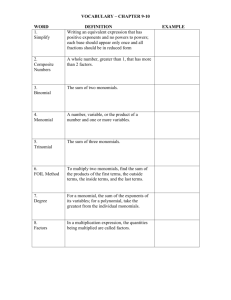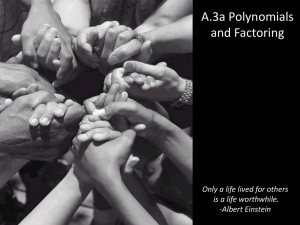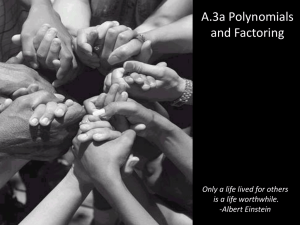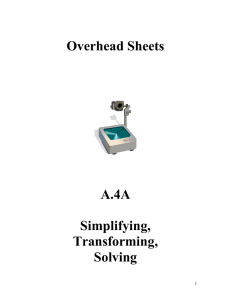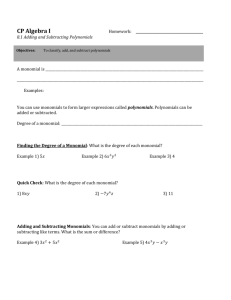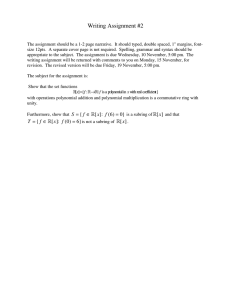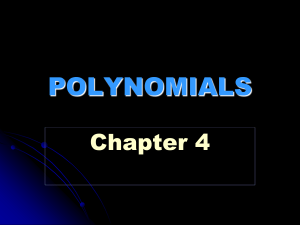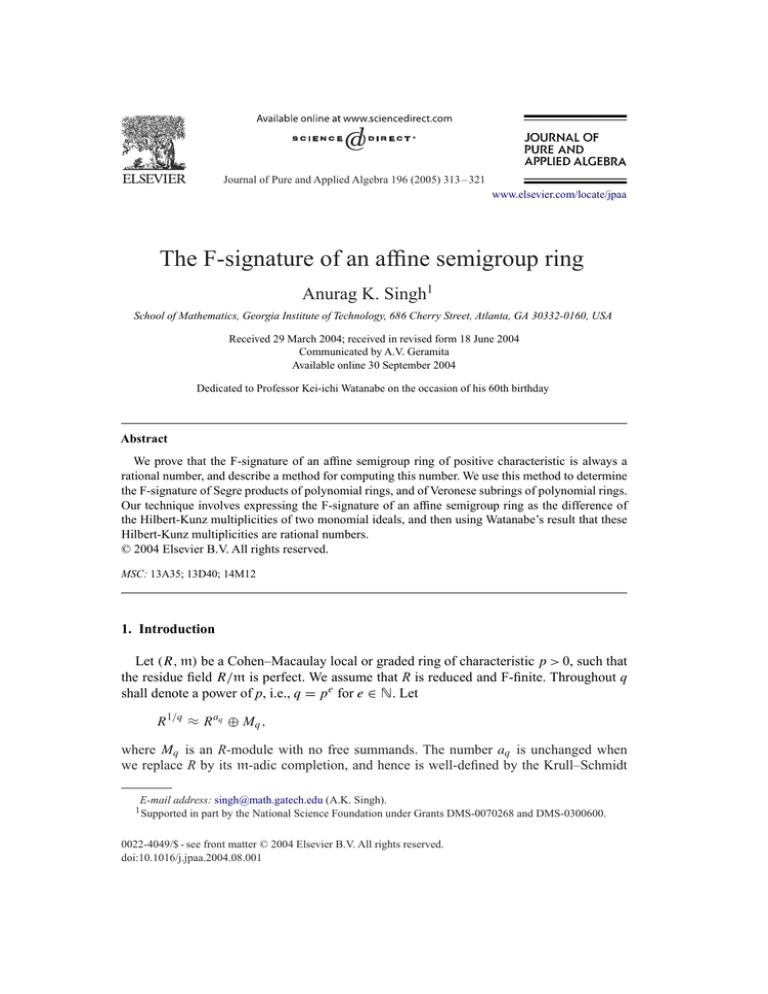
Journal of Pure and Applied Algebra 196 (2005) 313 – 321
www.elsevier.com/locate/jpaa
The F-signature of an affine semigroup ring
Anurag K. Singh1
School of Mathematics, Georgia Institute of Technology, 686 Cherry Street, Atlanta, GA 30332-0160, USA
Received 29 March 2004; received in revised form 18 June 2004
Communicated by A.V. Geramita
Available online 30 September 2004
Dedicated to Professor Kei-ichi Watanabe on the occasion of his 60th birthday
Abstract
We prove that the F-signature of an affine semigroup ring of positive characteristic is always a
rational number, and describe a method for computing this number. We use this method to determine
the F-signature of Segre products of polynomial rings, and of Veronese subrings of polynomial rings.
Our technique involves expressing the F-signature of an affine semigroup ring as the difference of
the Hilbert-Kunz multiplicities of two monomial ideals, and then using Watanabe’s result that these
Hilbert-Kunz multiplicities are rational numbers.
© 2004 Elsevier B.V. All rights reserved.
MSC: 13A35; 13D40; 14M12
1. Introduction
Let (R, m) be a Cohen–Macaulay local or graded ring of characteristic p > 0, such that
the residue field R/m is perfect. We assume that R is reduced and F-finite. Throughout q
shall denote a power of p, i.e., q = p e for e ∈ N. Let
R 1/q ≈ R aq ⊕ Mq ,
where Mq is an R-module with no free summands. The number aq is unchanged when
we replace R by its m-adic completion, and hence is well-defined by the Krull–Schmidt
E-mail address: singh@math.gatech.edu (A.K. Singh).
1 Supported in part by the National Science Foundation under Grants DMS-0070268 and DMS-0300600.
0022-4049/$ - see front matter © 2004 Elsevier B.V. All rights reserved.
doi:10.1016/j.jpaa.2004.08.001
314
A.K. Singh / Journal of Pure and Applied Algebra 196 (2005) 313 – 321
theorem. In [7] Huneke and Leuschke define the F-signature of R as
aq
s(R) = lim dim R ,
q→∞ q
provided this limit exists. In this note we study the F-signature of normal monomial rings,
and our main result is
Theorem 1. Let K be a perfect field of positive characteristic, and R be a normal subring of
a polynomial ring K[x1 , . . . , xn ] which is generated, as a K-algebra, by monomials in the
variables x1 , . . . , xn . Then the F-signature s(R) exists and is a positive rational number.
Moreover, s(R) depends only on the semigroup of monomials generating R and not on
the characteristic of the perfect field K.
We also develop a general method for computing s(R) for monomial rings, and use it to
determine the F-signature of Segre products of polynomial rings, and of Veronese subrings
of polynomial rings.
In general, it seems reasonable to conjecture that the limit s(R) exists and is a rational number. Huneke and Leuschke proved that the limit exists if R is a Gorenstein ring,
[7, Theorem 11]. They also proved that a ring R is weakly F-regular whenever the limit is
positive, and this was extended by Aberbach and Leuschke in [2].
Theorem 2. (Huneke and Leuschke [7], Aberbach and Leuschke [2]). Let (R, m) be an
F-finite reduced Cohen–Macaulay ring of characteristic p > 0. Then R is strongly F-regular
if and only if
aq
lim sup dim R > 0.
q→∞ q
Further results on the existence of the F-signature are obtained by Aberbach and Enescu
in the recent preprint [1]. Also, the work of Watanabe and Yoshida [12] and Yao [13] is
closely related to the questions studied here.
We mentioned that a graded R-module decomposition of R 1/q was used by Peskine–Szpiro,
Hartshorne and Hochster, to construct small Cohen–Macaulay modules for R in the case
where R is an N-graded ring of dimension three, finitely generated over a field R0 of characteristic p > 0, see [5, Section 5 F]. The relationship between the R-module decomposition
of R 1/q and the singularities of R was investigated by Smith and Van den Bergh in [9].
2. Semigroup rings
The semigroup of nonnegative integers will be denoted by N. Let x1 , . . . , xn be variables over a field K. By a monomial in the variables x1 , . . . , xn , we will mean an element
x1h1 · · · xnhn ∈ K[x1 , . . . , xn ] where hi ∈ N. We frequently switch between semigroups
of monomials in x1 , . . . , xn and subsemigroups of Nn , where we identify a monomial
x1h1 · · · xnhn with (h1 , . . . , hn ) ∈ Nn . A semigroup M of monomials is normal if it is finitely
generated, and whenever a, b and c are monomials in M such that abk =ck for some positive
A.K. Singh / Journal of Pure and Applied Algebra 196 (2005) 313 – 321
315
integer k, then there exists a monomial ∈ M with k =a. It is well-known that a semigroup
M of monomials is normal if and only if the subring K[M] ⊆ K[x1 , . . . , xn ] is a normal
ring, see [3, Proposition 1].
A semigroup M of monomials is full if whenever a, b and c are monomials such that
ab = c and b, c ∈ M, then a ∈ M. By Hochster [3, Proposition 1], a normal semigroup of
monomials is isomorphic (as a semigroup) to a full semigroup of monomials in a possibly
different set of variables.
Lemma 3. Let A = K[x1 , . . . , xn ] be a polynomial ring over a field K, and R ⊆ A be
a subring generated by a full semigroup of monomials. Let m denote the homogeneous
maximal ideal of R, and assume that R contains a monomial in which each variable xi
occurs with positive exponent. For positive integers t, let at denote the ideal of R generated
by the monomials in R which do not divide t .
(1) The ideals at are irreducible and m-primary, and the image of t generates the socle
of the ring R/at .
(2) The ideals at form a non-increasing sequence a1 ⊇ a2 ⊇ a3 ⊇ . . . which is cofinal with
the sequence m ⊇ m2 ⊇ m3 ⊇ . . . .
(3) Let M be a finitely generated R-module with no free summands. Then t M ⊆ at M for
all t 0.
(4) Let K be a perfect field of characteristic p > 0, and R 1/q ≈ R aq ⊕ Mq be an R-module
decomposition of R 1/q where Mq has no free summands. Then
aq = R
[q]
at :R tq
for all t 0.
Proof. (1) It suffices to consider t = 1 and a = a1 . Every non-constant monomial in R has a
suitably high power which does not divide , so a is m-primary. If ∈ R is any monomial of
positive degree, then ∈ a, and so m ⊆ a:R . Also ∈
/ a, so we conclude that a:R = m.
Since a is a monomial ideal, the socle of R/a is spanned by the images of some monomials.
If ∈ R is a monomial whose image is a nonzero element of the socle of R/a, then = for a monomial ∈ R. If ∈ m then ∈ m ⊆ a, a contradiction. Consequently we must
have = 1, i.e., = .
(2) Since each xi occurs in ∈ R with positive exponent and R is generated by a full
semigroup of monomials, we see that
at ⊆ (x1t+1 , . . . , xnt+1 )A ∩ R.
It follows that {at }t∈N is cofinal with the sequence of ideals {mt }t∈N .
(3) For an arbitrary element m ∈ M, consider the homomorphism : R → M given by
r → rm. Since the module M has no free summands, is not a split homomorphism. By
Hochster [4, Remark 2], there exists t0 ∈ N such that t0 m ∈ at0 M, equivalently, such that
the induced map
t0 : R/at0 → M/at0 M
316
A.K. Singh / Journal of Pure and Applied Algebra 196 (2005) 313 – 321
is not injective. If t : R/at → M/at M is injective for some t t0 , then it splits since
R/at is a Gorenstein ring of dimension zero; however this implies that the map
t0 : R/at
R/at0 → M/at M
R/at0
R/at
R/at
splits as well, which is a contradiction. Consequently t (t ) = 0, and hence t m ∈ at M
for all t t0 . The module M is finitely generated, and so we must have t M ⊆ at M for
all t 0.
(4) For any ideal b ⊆ R, we have
Mq
R 1/q ∼ R aq
⊕
=
bR 1/q
bR
bM q
and so
R
b[q]
R 1/q
=
bR 1/q
Mq
R
= aq +
.
b
bMq
Using this for the ideals at and at + t R and taking the difference, we get
Mq
Mq
R
R
aq −
−
+
a
at + t R
aM
a M + t M q
t t q
t q
R
R
R
= [q] − [q]
= [q]
at
at + tq R
at :R tq
By (3) t Mq ⊆ at Mq for all t 0, and the result follows.
Lemma 4. Let K be a perfect field of characteristic p > 0, and R be a subring of A =
K[x1 , . . . , xn ] generated by a full semigroup of monomials with the property that for every
i with 1 i n, there exists a monomial ai ∈ A in the variables x1 , . . . , xi , . . . , xn such
that ai /xi = i /i for monomials i , i ∈ R. Let 0 ∈ R be a monomial in which each xi
occurs with positive exponent, and set = 0 1 · · · n . For t 1, let at be the ideal of R
generated by monomials in R which do not divide t . Then, for every prime power q = p e
and integer t 1, we have
[q]
[q]
at :R tq = mA ∩ R
where mA = (x1 , . . . , xn )A is the maximal ideal of A. If R 1/q ≈ R aq ⊕ Mq is an R-module
decomposition of R 1/q where Mq has no free summands, then
R
R
aq = [q]
=
for all q = p e and t 1.
[q]
at :R tq
mA ∩ R
Proof. By Lemma 3(4), it suffices to prove that
[q]
[q]
at :R tq = mA ∩ R
for all q = p e and t 1.
A.K. Singh / Journal of Pure and Applied Algebra 196 (2005) 313 – 321
317
[q]
Given a monomial r ∈ at :R tq , there exists a monomial ∈ R which does not divide t
for which r tq ∈ q R. Since t / is an element of the fraction field of R which is not in R,
we must have t / ∈
/ A and so A:A t ⊆ mA . Taking Frobenius powers over the regular
ring A, we get
[q]
q A:A tq ⊆ mA
[q]
[q]
[q]
and hence r ∈ mA ∩ R. This shows that at :R tq ⊆ mA ∩ R.
q
For the reverse inclusion, consider a monomial bx i ∈ R where b ∈ A. Then
t q
q tq
q i
bx i = ba i
,
i
q
where ba i and t i /i are elements of R. It remains to verify that t i /i ∈ at , i.e., that
it does not divide t in R. Since
t
t i /i
=
ai
,
xi
this follows immediately.
Lemma 5. Let R be a normal monomial subring of a polynomial ring over a field K. Then
R is isomorphic to a subring R of a polynomial ring A=K[x1 , . . . , xn ] where R is generated
by a full semigroup of monomials, and for every 1 i n, there exists a monomial ai ∈ A
in the variables x1 , . . . , xi , . . . , xn , for which ai /xi is an element of the fraction field of R.
Proof. Let M ⊆ Nr be the subsemigroup corresponding to the inclusion of rings R ⊆
K[y1 , . . . , yr ]. Let W ⊆ Qr denote the Q-vector space spanned by M, and W ∗ =
HomQ (W, Q) be its dual vector space. Then
U = {w ∗ ∈ W ∗ : w∗ (m) 0
for all m ∈ M}
is a finite intersection of half-spaces in W ∗ . Let w1∗ , . . . , wn∗ ∈ U be a minimal Q+ generating set for U, where Q+ denotes the nonnegative rationals. Replacing each wi∗ by
a suitable positive multiple, we may ensure that wi∗ (m) ∈ N for all m ∈ M, and also that
wi∗ (M)a Z for any integer a 2. It is established in [3, Section 2] that the map T : W →
Qn given by
T = (w1∗ , . . . , wn∗ )
takes M to an isomorphic copy T (M) ⊆ Nn , which is a full subsemigroup of Nn . Let
R ⊆ A = K[x1 , . . . , xn ] be the monomial subring corresponding to T (M) ⊆ Nn .
Fix i with 1 i n. Since wi∗ (M)a Z for any integer a 2, the fraction field of R
contains an element x1h1 · · · xnhn such that h1 , . . . , hn ∈ Z and hi = −1. Also, there exists
m ∈ M such that wi∗ (m) = 0 and wj∗ (m) = 0 for all j = i. Consequently R contains a
monomial = x1s1 · · · xnsn with si = 0 and sj > 0 for all j = i. For a suitably large integer
t 1, the element
x1h1 · · · xnhn t = ai /xi
318
A.K. Singh / Journal of Pure and Applied Algebra 196 (2005) 313 – 321
belongs to the fraction field of R where ai ∈ A is a monomial in the variables
x1 , . . . , xi , . . . , xn . Proof of Theorem 1. By Lemma 5, we may assume that R is a monomial subring
of A = K[x1 , . . . , xn ] satisfying the hypotheses of Lemma 4. For the choice of as in
[q]
Lemma 4, the ideals at :R tq do not depend on t ∈ N. Setting a = a1 we get
R
R
R
=
−
,
aq = [q]
a :R q
a[q]
a[q] + q R
i.e., aq , as a function of q =p e , is a difference of two Hilbert–Kunz functions. Let d =dim R.
By Monsky [8] the limits
1
1
R
R
eHK (a) = lim d [q]
and eHK (a + R) = lim d [q]
q→∞ q
q→∞ q
a
a + q R
exist, and by Watanabe [11] they are rational numbers. Consequently the limit
lim
q→∞
aq
= eHK (a) − eHK (a + R)
qd
exists and is a rational number. The ring R is F-regular, so the positivity of s(R) follows from
the main result of [2]; as an alternative proof, we point out that ∈
/ a∗ , and consequently
eHK (a) > eHK (a + R) by Hochster and Huneke [6, Theorem 8.17].
By Watanabe [11] the Hilbert–Kunz multiplicities eHK (a) and eHK (a + R) do not depend
on the characteristic of the field K, and so the same is true for s(R). Remark 6. Let (R, m, K) be a local or graded ring of characteristic p > 0, and let ∈
ER (K) be a generator of the socle of the injective hull of K. In [12] Watanabe and Yoshida
define the minimal relative Hilbert–Kunz multiplicity of R to be
mHK (R) = lim inf
e→∞
(R/annR (F e ()))
,
p de
where d = dim R. They compute mHK (R) in the case R is the Segre product of polynomial
rings [12, Theorem 5.8]. Their work is closely related to our computation of s(R) in the
example below.
3. Examples
Example 7. Let K be a perfect field of positive characteristic, and consider integers r, s 2.
Let R be the Segre product of the polynomial rings K[x1 , . . . , xr ] and K[y1 , . . . , ys ], i.e.,
R is subring of A = K[x1 , . . . , xr , y1 , . . . , ys ] generated over K be the monomials xi yj
for 1 i r and 1 j s. It is well-known that R is isomorphic to the determinantal ring
obtained by killing the size two minors of an r × s matrix of indeterminates, and that the
dimension of the ring R is d = r + s − 1. Lemma 4 enables us to compute not just the
F-signature s(R), but also a closed-form expression for the numbers aq .
A.K. Singh / Journal of Pure and Applied Algebra 196 (2005) 313 – 321
319
The rings R ⊆ A satisfy the hypotheses of Lemma 4, and so
R
K[x1 , . . . , xr ] K[y1 , . . . , ys ]
aq = #
,
=
q
q
q
q
[q]
(x1 , . . . , xr )
(y1 , . . . , ys )
mA ∩ R
where # denotes the Segre product. The Hilbert–Poincaré series of these rings are
K[x1 , . . . , xr ]
K[y1 , . . . , ys ]
(1 − uq )r
(1 − v q )s
Hilb
Hilb
q
q ,u =
q
q ,v =
r ,
(1 − u)
(1 − v)s
(x1 , . . . , xr )
(y1 , . . . , ys )
and so aq is the sum of the coefficients of ui v i in the polynomial
(1 − uq )r (1 − v q )s
∈ Z[u, v].
(1 − u)r (1 − v)s
Therefore aq equals the constant term of the Laurent polynomial
us (1 − uq )r+s
(1 − uq )r (1 − u)−q )s
=
∈ Z[u, u−1 ],
(1 − u)r (1 − u−1 )s
usq (1 − u)r+s
and hence the coefficient of us(q−1) in
r+s
r+s
q
(1 − u )
r +s
d +n
uiq
un .
=
(−1)i
i
d
(1 − u)r+s
n0
i=0
Consequently we get
d + s(q − 1) − iq
d
i=0
s
q(s − i) + d − s
i d +1
=
,
(−1)
i
d
aq =
s
(−1)i
r +s
i
i=0
where we follow the convention that
m
n
= 0 unless 0 n m. This shows that the
F-signature of R is
s(R) = lim
q→∞
s
aq
1 i d +1
(s − i)d .
=
(−1)
i
qd
d!
i=0
We point out that s(R) = A(d, s)/d! where the numbers
s
d +1
A(d, s) =
(s − i)d
(−1)i
i
i=0
are the Eulerian numbers, i.e., the number of permutations of d objects with s − 1 descents;
more precisely, A(d, s) is the number of permutations = a1 a2 · · · ad ∈ Sd whose descent
set
D() = {i : ai > ai+1 }
320
A.K. Singh / Journal of Pure and Applied Algebra 196 (2005) 313 – 321
has cardinality s − 1, see [10, Section 1.3]. These numbers satisfy the recursion
A(d, s) = sA(d − 1, s) + (d − s + 1)A(d − 1, s − 1)
where A(1, 1) = 1.
Example 8. Let K be a perfect field of positive characteristic. For integers n 1 and d 2,
let R be the nth Veronese subring of the polynomial ring A=K[x1 , . . . , xd ], i.e., R is subring
of A which is generated, as a K-algebra, by the monomials of degree n. In the case d = 2
and p n, the F -signature of R is s(R) = 1/n, as worked out in [7, Example 17].
It is readily seen that the rings R ⊆ A satisfy the hypotheses of Lemma 4, and therefore
R
aq = .
[q]
mA ∩ R
Consequently aq equals the sum of the coefficients of 1, t n , t 2n , . . . in
K[x1 , . . . , xd ]
(1 − t q )d
Hilb
= (1 + t + t 2 + · · · + t q−1 )d .
q
q ,t =
(x1 , . . . , xd )
(1 − t)d
Let f (m) be the sum of the coefficients of powers of t n in
(1 + t + t 2 + · · · + t m−1 )d .
A routine computation using, for example, induction on d, gives us f (n) = nd−1 , and it
follows that
f (kn) = k d f (n) = k d nd−1 .
To obtain bounds for aq = f (q), choose integers ki with k1 n q k2 n where 0 |q −
ki n| n − 1. Then f (k1 n) f (q) f (k2 n), and hence
q − n + 1 d d−1
q + n − 1 d d−1
d d−1
d d−1
n
k1 n
aq k 2 n
n .
n
n
Consequently,
aq =
qd
+ O(q d−1 ),
n
and s(R) = 1/n .
Acknowledgements
I would like to thank Ezra Miller for several useful discussions.
References
[1] I.M. Aberbach, F. Enescu, When does the F-signature exist? preprint.
A.K. Singh / Journal of Pure and Applied Algebra 196 (2005) 313 – 321
321
[2] I.M. Aberbach, G.J. Leuschke, The F-signature and strong F-regularity, Math. Res. Lett. 10 (2003) 51–56.
[3] M. Hochster, Rings of invariants of tori, Cohen–Macaulay rings generated by monomials, and polytopes,
Ann. of Math. 96 (2) (1972) 318–337.
[4] M. Hochster, Contracted ideals from integral extensions of regular rings, Nagoya Math. J. 51 (1973) 25–43.
[5] M. Hochster, Big Cohen–Macaulay modules and algebras and embeddability in rings of Witt vectors,
Conference on Commutative Algebra—1975 Queen’s Univ., Kingston, Ont., 1975, pp. 106–195. Queen’s
Papers on Pure and Applied Math., No. 42, Queen’s Univ., Kingston, Ont., 1975.
[6] M. Hochster, C. Huneke, Tight closure, invariant theory, and the Briançon-Skoda theorem, J. Amer. Math.
Soc. 3 (1990) 31–116.
[7] C. Huneke, G.J. Leuschke, Two theorems about maximal Cohen–Macaulay modules, Math. Ann. 324 (2002)
391–404.
[8] P. Monsky, The Hilbert–Kunz function, Math. Ann. 263 (1983) 43–49.
[9] K.E. Smith, M. Van den Bergh, Simplicity of rings of differential operators in prime characteristic, Proc.
London Math. Soc. 75 (3) (1997) 32–62.
[10] R. Stanley, Enumerative Combinatorics, Vol. I, Wadsworth & Brooks/Cole Advanced Books & Software,
Monterey, CA, 1986.
[11] K.-i. Watanabe, Hilbert–Kunz multiplicity of toric rings, Proc. Inst. Natural Sci., Nihon Univ. 35 (2000)
173–177.
[12] K.-i. Watanabe, K.-i. Yoshida, Minimal relative Hilbert–Kunz multiplicity, Illinois J. Math. 428 (2004)
273–294.
[13] Y. Yao, Observations on the F-signature of local rings of characteristic p, preprint.



